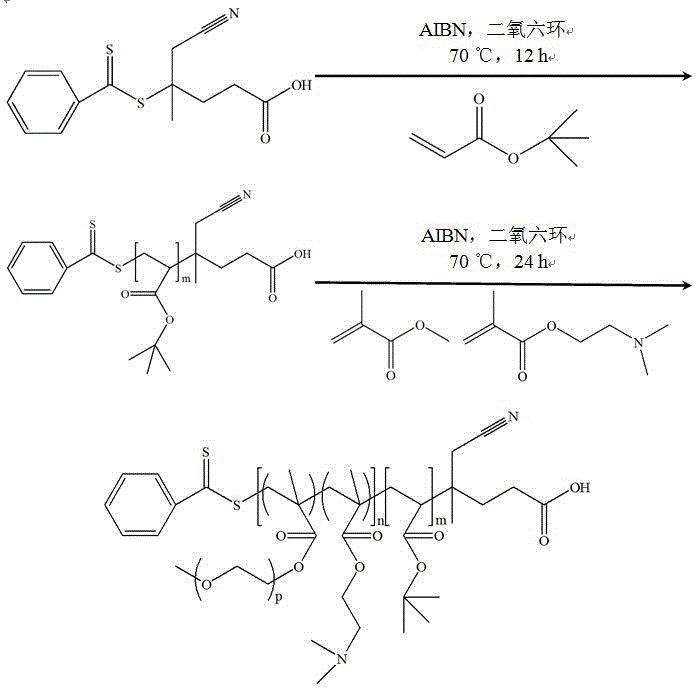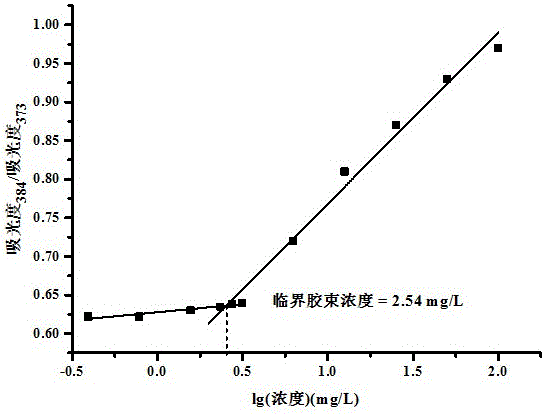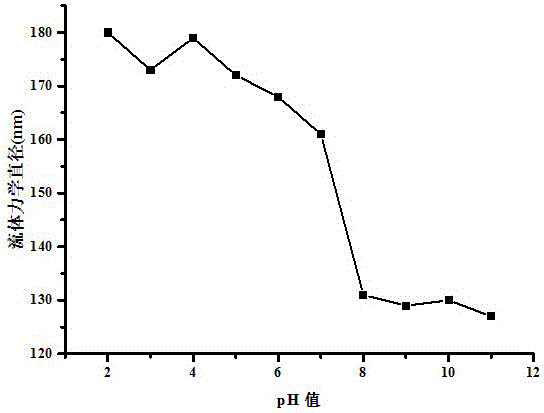Preparation method for amphiphilic segmented copolymer with pH value and temperature sensitivities
A multi-block copolymer and amphiphilic technology, which is applied in the field of preparation of amphiphilic multi-block copolymer P-b-P, can solve the problems of ATRP polymerization development limitation, inapplicability of direct polymerization, low reaction rate, etc. The effects of wide range of monomers, high yield, and high polymerization rate
- Summary
- Abstract
- Description
- Claims
- Application Information
AI Technical Summary
Problems solved by technology
Method used
Image
Examples
Embodiment 1
[0022] Step 1: Weigh 2.75 g tert-butyl acrylate (tBA) into a 50 mL single-necked round bottom flask, take 20 mg 4-cyano-4-(thiobenzoyl)valeric acid and 3.52 mg azobis Dissolve isobutyronitrile in a 50 mL beaker by adding 10 mL of dioxane. Then the two were mixed, and the one-necked flask was evacuated at 0 °C through the "T-shaped" tee, and nitrogen gas was introduced. Under the protection of nitrogen, put it in an oil bath at 70°C for 12 h, and stir evenly with magnetic force. After the reaction was completed, the flask was cooled in an ice-water bath and ventilated to the atmosphere, and the cooled solution was added dropwise to 200 mL of methanol / water (v: v = 2: 1) mixed solution, allowed to stand for 4 h, and the upper layer liquid was removed to obtain Pale pink precipitate at the bottom. The above precipitation step was repeated once, and finally the sample was vacuum-dried at 40 °C for 48 h to obtain a pale pink sample, namely poly(tert-butyl acrylate) (P(tBA)).
[...
Embodiment 2
[0028] Compared with Example 1, the amount of tert-butyl acrylate (P(tBA)) in the first step is changed to 2.29 g, and other conditions remain unchanged, then the monomer tert-butyl acrylate, chain transfer agent 4-cyano The molar ratio of base-4-(thiobenzoyl)valeric acid and initiator azobisisobutyronitrile becomes 250: 1: 0.3.
Embodiment 3
[0030] Compared with Example 1, the amount of tert-butyl acrylate (P(tBA)) in the first step is changed to 1.84 g, and other conditions remain unchanged, then the monomer tert-butyl acrylate and chain transfer agent 4-cyanide in the system The molar ratio of base-4-(thiobenzoyl)valeric acid and initiator azobisisobutyronitrile becomes 200: 1: 0.3.
PUM
 Login to View More
Login to View More Abstract
Description
Claims
Application Information
 Login to View More
Login to View More - R&D
- Intellectual Property
- Life Sciences
- Materials
- Tech Scout
- Unparalleled Data Quality
- Higher Quality Content
- 60% Fewer Hallucinations
Browse by: Latest US Patents, China's latest patents, Technical Efficacy Thesaurus, Application Domain, Technology Topic, Popular Technical Reports.
© 2025 PatSnap. All rights reserved.Legal|Privacy policy|Modern Slavery Act Transparency Statement|Sitemap|About US| Contact US: help@patsnap.com



